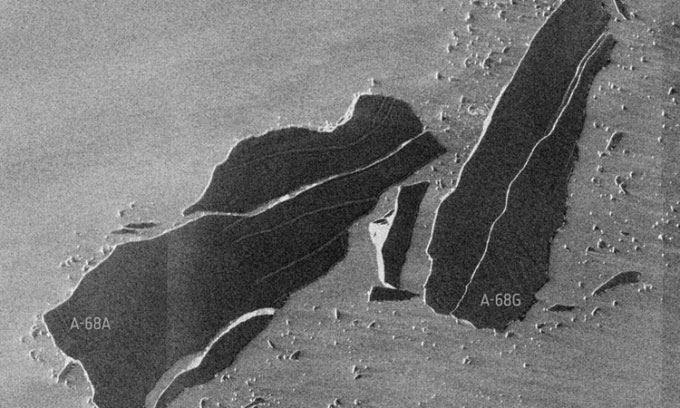The A-68A iceberg releases a massive amount of freshwater and nutrients into the ocean, potentially impacting the surrounding ecosystem.
In a statement on January 20, the European Space Agency (ESA) announced that the A-68A iceberg has released a colossal volume of freshwater near South Georgia Island, which could significantly affect marine life in the area. Specifically, this volume amounts to 152 billion tons. According to the University of Leeds (UK), this is equivalent to 20 times the volume of Loch Ness or 61 million Olympic-sized swimming pools.

The A-68A iceberg and ice fragments, alongside a large piece of A-68, known as A-68G, in a satellite image from 2021. (Photo: European Space Agency).
Researchers used satellite data and images to measure the amount of meltwater from A-68A and published their findings in the journal Remote Sensing of Environment.
A-68A is the largest piece of the A-68 iceberg that broke off from the Larsen C Ice Shelf in Antarctica in 2017. A-68 is one of the largest icebergs ever recorded. It separated from the ice shelf through a normal natural process.
Three years later, it drifted into warmer waters and threatened South Georgia Island, an important habitat for penguins, seals, and other wildlife. Fortunately, this massive iceberg later broke apart.
Along with freshwater, A-68A also released many nutrients into the ocean. “This is a huge amount of water from melting ice. The next thing we want to understand is whether it has a positive or negative impact on the ecosystem around South Georgia,” said Anne Braakmann-Folgmann, a researcher at the University of Leeds.
At the end of 2020, ecologist Geraint Tarling from the British Antarctic Survey (BAS) noted that the dust contained in the iceberg could provide nutrients for marine phytoplankton, thereby promoting the local food chain.
According to BAS, South Georgia is a crucial habitat for seals, endangered bird species, fish, and migratory whales. While the risk of A-68A running aground is no longer a concern, new questions arise regarding the effects of the water and nutrients from the iceberg on the ecosystem in this area. Scientists will need more time to find the answers.


















































